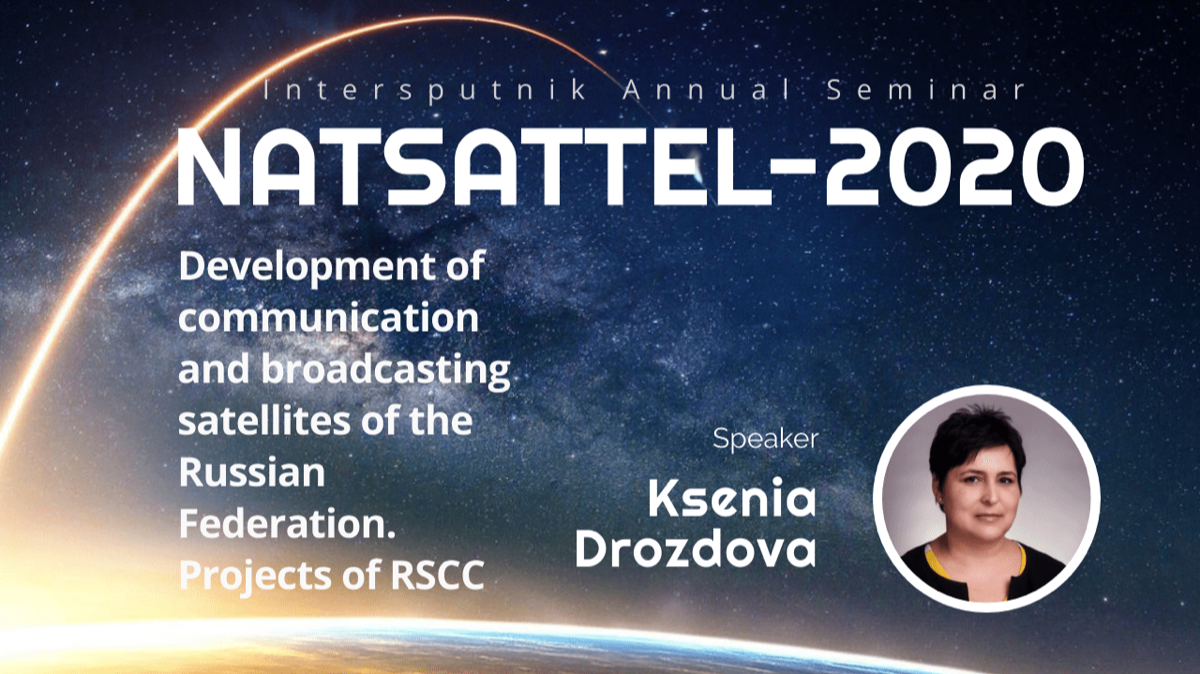NatSatTel-2020, Online event
Development of National Satellite Telecommunications Systems in the Member-Countries of Intersputnik, new projects and technologies
10 November, 2020
Seminar program
Format
Zoom webinar
Sponsor
Regional Projects Development Division (RPDD), Intersputnik Directorate
Moderators
Ksenia DROZDOVA, Chairperson of the Operations Committee of Intersputnik, Deputy Director General of RSCC;
Vladimir GLEBSKIY, Regional Projects Development Director, Intersputnik IOSC
Vladimir GLEBSKIY, Regional Projects Development Director, Intersputnik IOSC
Main Topic
exchange of information and experience among Intersputnik member-countries with respect to global satellite telecommunications market evolution, national satellite telecommunications systems development, discussion of topical issues, new areas, projects, technologies, and capabilities available to the member-countries for future expansion of their national satellite networks.
Program .pdf
10:00 - 10:05
Organizer’s opening speech (information from the organizers about the purpose of the event, the participants and the rules of the event. Giving the floor to the moderator of the first section)
GLEBSKIY Vladimir
Regional Projects Development Director, Intersputnik
Regional Projects Development Director, Intersputnik
-
SESSION 1
The first part of the seminar - national projects of member countries, information on the current state of the global satellite communications market, experts opinions on current problems of the development of domestic and international satellite systems
10:05 - 10:25
Development of communication and broadcasting satellites of the Russian Federation. Projects of RSCC
DROZDOVA Ksenia
Deputy Director General for Business Development of the Russian Satellite Communication Company (RSCC)
10:25 - 10:45
Azercosmos projects on the domestic and international satellite markets
Natavan Hasanova,
Business Development Department, Azercosmos![]()
10:45 - 11:05
Current status and development of satellite communications in Mongolia
DULGUUNTENGIS
Executive Director, Isatcom LLC![]()
11:05 - 11:25
Global FSS market: the Flood in LEO segment, strong gale in GEO sector and [temporary?] safe harbor of the regional markets
KONIK Leonid
Chief Editor, COMNEWS group![]()
11:25 - 11:45
Development of the Nationsat project: types of satellites for the protection of satellite resources and the development of national satellite programs
BAITSUR Grigory
Technical Director, Intersputnik11:45 - 12:05
Potential growth trends of Intersputnik in the conditions of innovative space industry
STOYTCHEV Svetlomir
Finance Director, Intersputnik![]()
12:05 - 12:25
Space insurance market status
TKACHENKO Alexey
Divisional Director, Aviation & Space
AON Russia![]()
12:25 - 13:05
Q&A
Questions for discussion:- over the last several years there has noticeably increased the number of newly-established national satellite systems. What do you think encouraged that process, will it continue in the future and why?
- what factors do you think hamper the establishment of national and regional satellite constellations? How can these obstacles be overcome, what assistance do national operators and administrations need?
- what role should states and government programs play in your opinion in setting up and maintaining national satellite systems? What would you recommend as a tool to help such project make progress?
- practically all new LEO satellite constellations pose as global ones intended to serve customers the world over, and their business plans are based exactly on that. How does their establishment go together with plans of national satellite operators? Will these new systems be officially given access to markets in most countries?
- national systems set up in cooperation with foreign partners and investors. What is the demand for such tool, what are its prospects and limitations against the background of steadily growing competition?
- most experts agree that as a result of a quantum leap in the development of new technologies simultaneously in various fields (orbital insertion, satellite manufacture and operation, digital and telecommunications technologies …) there occurs an in-depth transformation of the satellite market and further aggravation of competition. Will these processes (in your opinion) encourage or impede the expansion of national satellite systems?
13.05 - 13.30
Break
-
SESSION 2
The second part of the seminar (presentations by experts, national telecom operators and satellite service providers) - new projects and technologies in the field of satellite communications
13.30 - 13.50
The results of WRC 2019, new opportunities for the development of satellite networks and 5G networks based on the decisions adopted by WRC 2019.
STRELETS Viktor
Chairman ITU-R Study Group 4, Scientific consultant of Radio Research and Development Institute![]()
13.50 - 14.10
Satellites for future market growth
ONILLON Bertrand
Telecom payload product line manager, Thales Alenia Space![]()
14.10 - 14.30
Jupiter Technology Innovations 2020 and beyond
LANIN Konstantin
Head of Representative Office HUGHES, Regional Director Russia & CIS Business
14.30 - 14.50
The project of creating Marathon, a global IoT network for the provision of IoT services. Issues and opportunities for cooperation
ANPILOGOV Valentin
Deputy Director General, VisatTel![]()
14:50 - 15:10
Gilat role in latest developments of the SatCom industry
LERER Barak
RVP EMEA, GILAT![]()
15:10 - 15:30
Eutelsat – new services and satellite solutions
BADALOV Karen
Regional Director – CIS countries, Baltic States, Bulgaria, Georgia, Eutelsat15:30 - 15:50
ISATEL: experience in implementing complex projects
ZABOLOTNYY Igor
CEO, Isatel LLC![]()
15:50 - 16:10
Intersputnik project Open Teleport: a new opportunity to optimize operators’ costs
LOBANOV Andrey
Head of operation group of Technical Department, Intersputnik![]()
16:10 - 17:00
Q&A, summarizing the results of the seminar
Questions for discussion:- we are aware that in the early days of O3b there were lots of promises to offer individual access to 3 billion users across a wide belt of equatorial countries, however, the B2B model was quickly replaced with B2C and the company re-focused on working with legal entities. To a great extent that happened because of the complexity and high cost of users terminals. Today, cheap individual equipment is promised by enthusiasts – those who are building LEO systems such as StalLink, OneWeb, and others. Can such projects have the same destiny?
- today much is being said about satellite telecommunications operators switching from the wholesaling to retailing, specifically, satellite owners tend to replace bulk sales of satellite capacity with ready-for-use services such as Internet access, which keeps steadily growing. However, this pattern of selling Mbits rather that MHerzs requires tremendous investments in ground infrastructure and a totally different operator technology. To what extent are operators ready to do so, how long will these processes last and can operators do this job on their own?
- the already mentioned switching of large operators – satellite owners to sales of end services pulls the carpet out from under many a satellite operator specializing in turn-key projects for end users. For example, some HTS systems (the so-called closed systems) do not plan to have any intermediaries whatsoever in the service sales chain. Is there any business left for them in the future or are they doomed like dinos?
- it is no secret that today most Internet users go online using various mobile devices (smart phones, tablets, etc.). How attractive and sought-after in this situation is the individual (mobile) satellite Internet set? What should it look like and how much should it cost on the mass market?
- only yesterday satellite manufacturers were telling us that a ‘big’ satellite was more advantageous that a ‘small’ one, because the cost per transponder was lower and the lifetime longer. Today, they are saying just the opposite referring to the opportunities of multiple launches, mass-scale manufacture etc. even in the case of GSO satellites. What do you think should be the criteria to be used by a customer to opt for, for example, a national or regional system?
- not long ago there were attempts to build the first flexible and/or adaptive payloads, which did not prove to be economically viable because they were noticeably more expensive while their advantages were not sought after adequately on the market. Today, flexible payloads are again trending. What new advantages do they offer and will those advantages still remain there over the lifetime of a satellite? Because the market and technologies change much faster.
- they tell us that the IoT market will skyrocket. What portion of this market will be served by satellites? Obviously, most sensors and ‘smart’ machines will be concentrated in areas covered by ground and cellular networks. So are there again only mobile objects in question or are there any other applications?
 Operations Committee
Operations Committee









